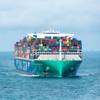New Convention to be adopted at IMO
A new international convention to prevent the potentially devastating effects of the spread of harmful aquatic organisms carried by ships' ballast water is set to be adopted at an international conference to be held from 9 to13 February 2004 at the London Headquarters of the International Maritime Organization (IMO), the United Nations agency responsible for the safety and security of shipping and the prevention of marine pollution from ships.
The proposed new instrument is being developed on the basis of a two-tier approach.
Tier 1 includes requirements that would apply to all ships, including mandatory requirements for a Ballast Water and Sediments Management Plan, a Ballast Water Record Book and a requirement that new ships carry out ballast water management procedures to a given standard. Existing ships would be required to do the same, but after a phase-in period.
Tier 2 gives Parties the option to take additional measures before ships would be allowed to enter their ports. Such additional measures are subject to criteria set in the draft convention and to IMO guidelines yet to be developed, and may also include additional controls applicable to discharge and/or uptake areas of ballast water.
IMO Secretary-General Mr. Efthimios E. Mitropoulos has highlighted the urgent need to agree the proposed new mandatory instrument to regulate the management of ship ballast water and sediment and prevent the transfer of unwanted species from one ecosystem to another.
"This is an extremely serious environmental issue which IMO has been working on for more than a decade. The fact of the matter is that ships, by carrying thousands of tonnes of ballast water from one part of the world to another, can transfer pathogens and other micro-organisms and invasive species which have the capacity to distort and destroy the very delicate balance which exists in the ecosystem of the region where the ballast water is offloaded," Mr. Mitropoulos said.
"Unlike oil spills and other marine pollution caused by shipping, exotic organisms and marine species cannot be cleaned up or absorbed into the oceans. Once introduced, they can be virtually impossible to eliminate and in the meantime may cause havoc" he added.
Specific examples include the introduction of the European zebra mussel (Dreissena polymorpha) in the Great Lakes between Canada and the United States, resulting in expenses of billions of dollars for pollution control and cleaning of fouled underwater structures and waterpipes; and the introduction of the American comb jelly (Mnemiopsis leidyi) to the Black and Azov Seas, causing the near extinction of anchovy and sprat fisheries.
The problem of invasive species is largely due to the expanded trade and traffic volume over the last few decades. The effects in many areas of the world have been devastating. Quantitative data show the rate of bio-invasions is continuing to increase at an alarming rate, in many cases exponentially, and new areas are being invaded all the time. Volumes of seaborne trade continue overall to increase and the problem may not yet have reached its peak.
It is estimated that about 10 billion tonnes of ballast water are transferred globally each year, potentially transferring from one location to another species of sealife that may prove ecologically harmful when released into a non-native environment.
The problem of harmful aquatic organisms in ballast water was first raised at IMO in 1988 and since then IMO's Marine Environment Protection Committee (MEPC), together with the Maritime Safety Committee (MSC) and technical sub-committees, have been dealing with the issue, focusing in the past decade first on guidelines and then on developing the new convention.
GloBallast Programme
In order to help developing countries understand the problem, monitor the situation and prepare for the convention, IMO is implementing the GEF/UNDP/IMO Global Ballast Water Management Programme (GloBallast: http://globallast.imo.org/ ) and has provided technical support and expertise.
The conference will be preceded by the GloBallast 5th Global Project Task Force (GPTF) Meeting scheduled to take place also at the IMO Headquarters from 3 to 6 February 2004.
Background
Scientists first recognized the signs of an alien species introduction after a mass occurrence of the Asian phytoplankton algae Odontella (Biddulphia sinensis) in the North Sea in 1903.
But it was not until the 1970s that the scientific community began reviewing the problem in detail. In the late 1980s, Canada and Australia were among countries experiencing particular problems with unwanted species, and they brought their concerns to the attention of IMO's Marine Environment Protection Committee (MEPC).
In 1991 the MEPC adopted MEPC resolution 50(31) - Guidelines for Preventing the Introduction of Unwanted Organisms and Pathogens from Ships' Ballast Water and Sediment Discharges; while the United Nations Conference on Environment and Development (UNCED), held in Rio de Janeiro in 1992, recognized the issue as a major international concern.
In November 1993, the IMO Assembly adopted resolution A.774(18) - Guidelines for Preventing the Introduction of Unwanted Organisms and Pathogens from Ships' Ballast Water and Sediment Discharges, based on the Guidelines adopted in 1991. The resolution requested the MEPC and the MSC to keep the Guidelines under review with a view to developing internationally applicable, legally-binding provisions.
The 20th Assembly of IMO in November 1997 adopted resolution A.868(20) - Guidelines for the control and management of ships' ballast water to minimize the transfer of harmful aquatic organisms and pathogens.
The development of the draft mandatory instrument has been continuing since then.
Sponsored Content
Innovative Hull Maintenance: Profitable & Green

Subscribe for
Maritime Reporter E-News
Maritime Reporter E-News is the maritime industry's largest circulation and most authoritative ENews Service, delivered to your Email five times per week












